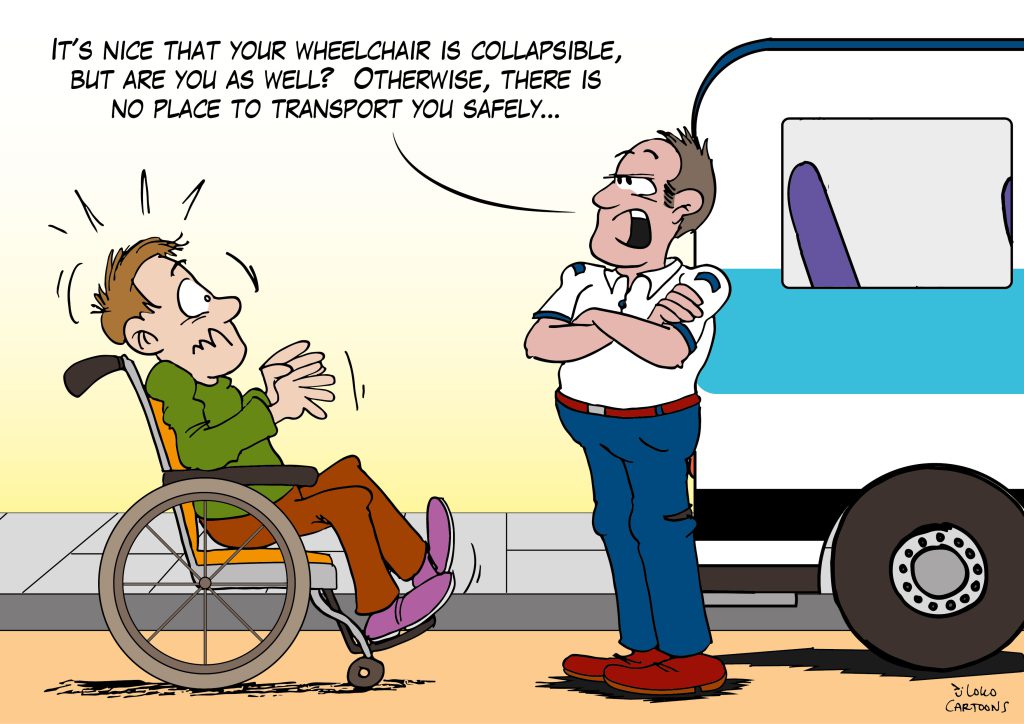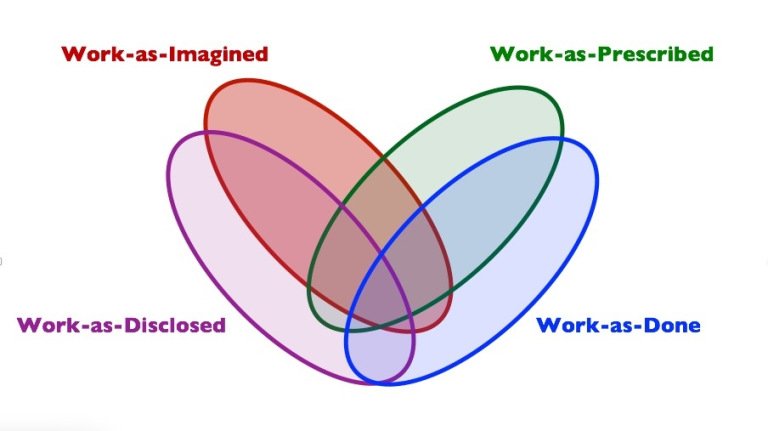This post is also available in: Nederlands (Dutch)

After starting my website with ideas about safe wheelchair transport, it is time to step aside to think about the future. How can I use my experience and knowledge to help those involved in transport? Is the branche, but much more important, are drivers and customers waiting for that?
How can safety in the wheelchair taxi sector be shaped differently, more from the experience of drivers, passengers and wheelchair manufacturers? Invest in what’s going well.
Work in the wheelchair taxi sector?
There is a distinction between: Work as imagined, Work as disclosed, Work as prescribed (checklists, protocols and on-board computer advice) and Work as done.

A sideview
As an example from aviation a well-ended near-fatal calamity: The Quantas 32 flight in 2010 opens in a new windowh ttps://www.youtube.com/watch?v=Bo_YVBLNYXU
It turns out:
- Procedures, checklists and on-board computer advice are not sufficient as a solution for the complex incident in this Quantas 32 example. Some on-board computer advice is even dangerous in this situation. (prescribed work)
- Ranks within the crew do not predominate, they think and work together under pressure. Time is taken for joint decisions if, where necessary, deviations are made from the procedures indicated by the on-board computer. (work variation / resilience of the pilots)
- Passengers are reassured as much as possible.
- An experienced, well-trained crew safely landed the badly damaged aircraft. (work done)
Complex system
Of course, the situation in a wheelchair taxi is not comparable to an airplane. But it is a complex situation, albeit of a different order.
There are many parties involved in the comfortable and safe transport for all wheelchair passengers:
- The client of wheelchair passenger transport is usually not the passenger, as with a normal taxi ride, but a municipality (WMO), insurer (care transport) or the government (Valys) (work as prescribed).
- Consultants and lawyers are involved in drafting complex contracts with requirements that sometimes go beyond the legal requirements in an attempt to ensure quality and safety (work as prescribed). Part of this is laid down in the Code VVR. (requirements and procedures)
- Both in the taxi and in the assistive aids sector, companies are (partly) represented by branch organizations.
- Transport companies must bid for contracts with a limited duration, and guarantee to deliver according to the set requirements. The financial situation in the wheelchair transport sector is tight and has not improved in times of corona (a prerequisite for striving for quality and safety).
- Taxibus manufacturers supply vehicles based on the requirements of the transport providers that are often linked to the requirements of the tender (tools, condition).
- Wheelchair manufacturers and wheelchair adaptation companies supply wheelchairs based on the functional requirements of the wheelchair user/passenger. One of these requirements is safe transport, but that is not the only and most important requirement (aids, condition).
- The carrier plans the journeys and accompanies the drivers in transporting (wheelchair) passengers according to the contract conditions (work communicated).
- Ultimately, the execution of the transport (the work as it is done) is in the hands of a driver who often has to make considerations about the accessibility, safety and comfort of the transport on his own (in consultation with the passenger). Under the (time) pressure of the entire system.
- The passenger has only limited influence on the system. Only through advocate Ieder(in) together with patient associations and interest groups can the transport process be influenced. And sometimes the passenger can participate in the provision of a suitable wheelchair based on years of experience expertise.
Starting point
My starting point is that every wheelchair user can use comfortable and safe taxi transport. All parties have a role to play in ensuring comfortable and safe transport. In addition, it is the driver and the wheelchair adaptation technician who make decisions and carry out the work on the cutting edge.
With the driver and wheelchair adaptation technician to make crucial decisions, it is obvious that drivers and technicians are properly trained and given the right tools to be able to make difficult decisions in this complex transport situation with always different passengers. That the transport company inquires with the drivers about their experiences from these complex practical situations, and supports them in this as well as possible. That drivers and carriers work together with wheelchair adaptation technicians and wheelchair manufacturers to come up with solutions that fit within the time pressure under which the driver has to work. That practical solutions that drivers come up with in daily practice are seen, picked up and shared to work on improvements to the entire complex system. That contractors know how the practice works, know the (im)possibilities of drivers, and take them into account when deciding on contracts. That there is a learning (safety) system in wheelchair transport.
Example from the healthcare sector:

for healthcare quality improvement using the CARE model.
Code VVR
As of 1 January 2022, the VVR Code, issued by the Social Mobility Fund, has been adopted. In many tenders, the Code is a requirement (TX-keur). There is an instruction card for the driver and a checklist for the wheelchair user based on this Code. https://www.sfmobiliteit.nl/index.php/werkgever/opleidingen-sfm/code-vvr
Briefly and not too subtly summarized: Driver: “Thou shalt transport safely and/or otherwise refuse transport.” Wheelchair passenger: “You only provide a wheelchair with which that is possible.”
Consequences for the driver
The driver is in a split. On the one hand, that instruction card with the brief indication “do safely or do not do”. And on the other hand, the complex practice with a large variation in wheelchair passengers with their functional limitations and customized wheelchairs. Not every driver has enough experience and knowledge to be able to cope with practical problems. There are also drivers with years of experience, who see themselves curtailed by such an instruction card. Who, for example, have been asking for a solution to the headrest problem for years, but are not sufficiently heard.
Where the client thinks along and does something with the signals that drivers and customers give, the quality of the (student) transport appears to increase by considerable steps. For example, in the Hoorn area. “It’s going well and it can always be better” is a positive approach that pays off.
Efficiency versus thoroughness
Budget discounts in transportation. Focus on an average boarding time. These factors limit the time available to secure passengers with a complex custom-made wheelchair in particular or to allow other passengers to transfer to a fixed seat.
It turns out to be difficult to fill vacancies of wheelchair taxi drivers. That is understandable. The job security is limited to the duration of a transport contract, about 4 to 6 years. And if something goes wrong, the driver is held responsible for decisions over which he/she has little or no influence in practice.
Financial
Out of a sample of 115 companies that provided care transport in 2017, 52% had a negative result! 1| In Den Helder, there appeared to be no bidders in the tender in 2019. 2| A sign that the limits have now more than been reached. In the Corona period, that has not improved. Not helpfull to innovation in transport. https://www.taxipro.nl/contractvervoer/2021/11/25/taxibedrijven-moeten-niet-meer-tegen-verlieslatende-tarieven-rijden/
Cost savings force companies to save on personnel costs, hire drivers at the UWV with wage subsidy. Then it is difficult to keep your job as an experienced driver. Growing possibilities to mentor driver or after further training to, for instance, ambulance- or executive driver are limited if you do not make it to the first 5 years.
Companies that do not join this race to the bottom, but invest in drivers and equipment, are struggling.
Safety
What does refusing transport, a term that appears no less than three times on the instruction card, have to do with safe transport for all wheelchair passengers?
If we do not trust the wheelchair manufacturer and therefore refuse a group of difficult customers, is the transport safe?
Of course, as in aviation, the transport company is responsible for the safety of passengers. He is not alone in this. If it is well arranged, the transport companiy can rely on professionals inside and outside his organization and on the efficiency of products. From top to bottom in that chain, the following applies: fulfill your duty of care. Do what you can to achieve good transportation, to make a good product. That’s what you’re judged on when something goes wrong. That’s what the law asks of you.
Care
Part of duty of care is care. In the unlikely event of an accident, provide care to the victim and to the employee (second victim). Reasoning back from the accident “what if the person responsible had made other choices?” is tempting, but not justified. It also doesn’t help to improve. After all, choices usually go well. Success and failure are each other’s downside. Don’t ask WHO is to blame, but WHAT caused the accident. An accident is a system error, in which people are part of the system. Ask what can we do to make the system work better, based on what is always going well. What can we do to make the system more robust? How can we train people in the system in such a way that they can respond resiliently, flexibly and proactively to risky situations?
Two examples to illustrate:
Example 1 – Complex Wheelchair
A quote from the checklist Code VVR for the user:
“Do you have an adapted complex wheelchair that (according to the supplier) cannot be crash tested? Even then, the driver’s assessment applies.”
A passenger with a complex wheelchair is going to make a train journey. For transport to and from the station, he reserves a wheelchair taxi. It’s going well on the ride forth. The driver sees good opportunities to secure the wheelchair and position the seat belt.
Late at night, at an abandoned cold station, another driver judges that the wheelchair is very complex. The instruction card Code VVR in mind, he finds it risky to take the wheelchair with him to transport. A diabolical dilemma. The planning and the taxi company are hardly accessible at this time for proper consultation. Moreover, it is cold.
Do transport, drive carefully and hope that nothing goes wrong? If something does happen, the logical response is “If only I had left it to stay?” Or refuse transport and read in the newspaper the next day “Wheelchair user exhausted and severely hypothermic, found on the way home ̈? Simple rules, based on mistrust, do not work in a complex environment! What, then, is just and humane to do?
It is the intention that the manufacturer/supplier indicates whether a wheelchair is safely transportable. Even if a crash test is not possible with a complex wheelchair! To this end, a risk analysis is made by the manufacturer/supplier. Then, rely on each other’s expertise!
The driver’s assessment does not have to be more than the check: Is the wheelchair in good condition? Compare it with a round of the pilot (with checklist) around the plane. The driver makes a choice. Often it goes well, rarely it goes wrong. And if it has gone wrong, we have to look further for the cause than just the “wrong” choice of the driver. What was the underlying situation, what training did the driver have to be able to make that choice properly? Etc, etc. Zoom out from the accident and look at the complex system instead of looking for a reductionist one cause, a human error. And above all: learn from the accident, it is drastic and costly enough.
Example 2 – Seat belt use
The checklist for users states:
“Not being able or willing to wear the seat belt in the right way is a reason to refuse you transport.”
Wheelchair passengers come in shapes and sizes. If the shoulder girdle at someone with dwarfism cuts into the neck when applied? Then the belt cannot be worn correctly. Is that reason to refuse this group of passengers? That can lead to uncomfortable situations and arguments. The driver can solve it?
Often a wheelchair bus with fixed wheelchair spaces is used and the adjustability of the shoulder belt is low. With a previously widely used system with rails, the adjustability was better. Then, if you could take the time, a solution could often be found. It seems to me that the buses are designed with transport of the entire target group in mind.
Another solution could be: The wheelchair passenger requests a new wheelchair with a seat belt attached in the wheelchair. This is already very common in other countries with, for example, children’s wheelchairs. The manufacturer/supplier indicates that the wheelchair is suitable as a seat in the transport. The wheelchair passes a crash test.
Then the bottleneck is a second checklist determination:
“The seat belt should be attached to the floor or the securing system, not to your wheelchair.” How can this be! Why is the professional on the wheelchair work floor not trusted?
Top down or together
Issuing top-down measures from behind a desk to cover liability is relatively easy. For line managers and clients, it is much more difficult to listen unbiasedly to what drivers, passengers and aid advisors experience and ask of you in complex practice. It is important that line managers have confidence in people on the work floor, on their experience and professionalism! Then you hardly need a Code VVR. Good education and the legal requirements then provide the basic skills to be able to make the right decisions responsibly. Collecting good practice examples and taking everyone’s contribution into the system, that gives more insight. These examples can then be used for the training.
Provide that safe environment for the professionals at the base. Support them, even if they are held responsible for a calamity.
Finally
For the past two years I have struggled with ideas of how to continue to promote safety and accessibility of transport in wheelchair transport, with tight budgets. In my opinion, the solution lay on the different work floors. But how?
Sidney Dekker has successfully applied the “Safety Different” approach in various organizations! His ideas have inspired me to write this opinion article whose content (except for the quotes and external links) is entirely my responsibility. Let us break the deadlock of bureaucratic rules and the culture of liability and actually achieve safe transport for every wheelchair user. Maybe his ideas can help us with that.
Sidney Dekker:
“People aren’t your problem, they’re your problem solver!”
On 25 January 2022, Ieder(in), Dwarslaesie Organisatie Nederland, Spierziekten Nederland and senior citizens’ organisation KBO-PCOB opened a hotline for wheelchair passengers who are refused transport for safety reasons:
opens in a new windowhttps://iederin.nl/code-vvr-aangepast-onzekerheid-voor-passagiers-met-complexe-aangepaste-rolstoel/
In consultation with the wheelchair passengers, the professionals on the work floor, drivers and wheelchair manufacturers, let us ask what they need to be able to carry out their work safely. This results in good practice, a wealth of experience and a positive approach, instead of focusing on what can go wrong and for which you can be held accountable as an organization. Invest in trust instead of fear! Then everyone grows.
I am available as a listening ear, am open to criticism and like to think along. You can respond via LinkedIn, under this blog or via the contact form on my website https://arenlezen.nl/contact/.
Background
Dekker about Safety Differently (eng):
Safety Differently movie (trailer)
and his lecture at the CanBetter Patient Safety Congress (nl):
1 Panteia, AIM Key figures for healthcare transport. 2017. Dec. 13 2018 p 10
2 TaxiPro Tender WMO transport Den Helder fails. 28 Oct. 2019.
https://www.taxipro.nl/contractvervoer/2019/10/28/aanbesteding-wmo-vervoer-den-helder-mislukt/
